Designing a food plate for dietary counselling of pregnant women in Bangladesh
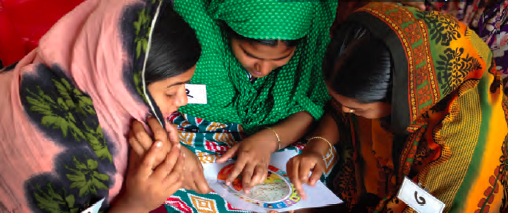 By Abu Ahmed Shamim, Kathrin Tegenfeldt, Kerry Aradhya, Tarana Ferdous, Nasrin Banu, Sumitra Roy, Raisul Haque, Saydur Rahman Siddiquee, Mosiqure Rahman and Nazma Shaheen
By Abu Ahmed Shamim, Kathrin Tegenfeldt, Kerry Aradhya, Tarana Ferdous, Nasrin Banu, Sumitra Roy, Raisul Haque, Saydur Rahman Siddiquee, Mosiqure Rahman and Nazma Shaheen
Abu Ahmed Shamim has managed nutrition intervention and research projects for the Bangladesh National Nutrition Council, CARE and Johns Hopkins University before joining FHI 360 as technical director of the SHIKHA project. He has steered the development and field-testing process of the food plate for Bangladeshi pregnant women and led the writing and editing of this article.
Kathrin Tegenfeldt is the former country director for the FHI 360 Bangladesh office. She served on the executive committee of the Civil Society Alliance for Scaling Up Nutrition in Bangladesh.
Kerry Aradhya is a science writer and editor at FHI 360 with extensive experience in the areas of global health, population and nutrition in developing countries.
Tarana Ferdous is a research officer at the Center for Injury Prevention and Research, Bangladesh. She was involved with the SHIKHA project as a consultant and USAID-supported fellowship at the James Pitter Grant School of Public Health, BRAC University.
Nasrin Banu is involved with the SHIKHA project through a USAID-supported fellowship at the James Pitter Grant School of Public Health, BRAC University and currently works as a consultant with FHI360.
Sumitro Roy has more than two decades of experience managing rural development, health and nutrition projects. He was the chief of party for the SHIKHA project and is currently the project director with the Alive & Thrive Initiative of Family Health International Solutions in Uttar Pradesh, India.
Raisul Haque heads the health, nutrition, and population programme at BRAC and has three decades of experience in public health service delivery and programme management.
Saydur Rahman Siddiquee managed public health and nutrition projects for the World Health Organization and Alive & Thrive before joining FHI 360 as a field programme manager for the SHIKHA project.
Mosiqure Rahman worked for ten years at PLAN International before joining FHI 360 as a monitoring and evaluation specialist for the SHIKHA project.
Nazma Shaheen is professor and director of the Institute of Nutrition and Food Science at Dhaka University. She has nearly three decades of teaching and research experience in nutrition and food science and was the lead scientist in the recent update of the Food Composition Table for Bangladesh.
Acknowledgements: The SHIKHA project (2013-2016) is implemented by FHI 360 in partnership with BRAC (Bangladesh’s largest non-governmental organisation). This analysis was made possible with generous support of the American people through the United States Agency for International Development (USAID) under Cooperative Agreement # AID- 388-A-13-00003. The contents are the responsibility of the authors and do not necessarily reflect the views of USAID or the United States Government. The authors acknowledge the contribution of the pregnant women and field workers of BRAC who contributed their time and the SHIKHA project implementation teams of BRAC health division and FHI 360 and experts from many organisations who shared their insights at different stages of developing the plate. The authors also acknowledge the contributions of Dr. Lalita Bhattacharjee, senior nutritionist, FAO; Dr. Mohammad Abdul Mannan, nutrition policy advisor, FAO and Dr. Quamrun Nahar, senior research officer, BIRDEM, for providing technical insights in developing the food plate.
Location: Bangladesh
What we know: Undernutrition is common among women in Bangladesh. For pregnant women, dietary diversity has been associated with nutrition sufficiency and good pregnancy outcomes.
What this article adds: One of the objectives of the SHIKHA project in Bangladesh is to promote dietary diversity among pregnant women through nutrition education and counselling. With this objective in mind, SHIKHA developed a food plate that is being used in Bangladesh as a counselling tool to promote a healthy, balanced diet during pregnancy. Experiences of developing the plate have shown that systematically consulting with pregnant women and frontline nutrition workers, as well as involving experts from relevant organisations in the process, helps ensure quality and acceptance of the plate and the messages it promotes. The experience in Bangladesh could serve as a model for the development of similar educational tools in other developing countries.
Background
Compared with other developing countries, Bangladesh has a high prevalence of undernutrition among women (Osmani & Sen, 2003). According to the 2011 Bangladesh Demographic and Health Survey (BDHS, 2011), 24% of married women aged between 15 to 49 years are undernourished (body mass index <18.5). In addition, deficiencies in iodine (Shamim, Christian, Schulze et al, 2012) vitamin B12, zinc (Shamim, Kabir, Merrill et al, 2014) and vitamin E (Shamim, Schulze, Merrill et al, 2015) have been reported among rural pregnant women. Lack of dietary diversity is common among poor and rural populations, particularly in developing countries where starchy staples are prominent and few, if any, animal products, fruits and vegetables are included in the daily diet.
Several studies have shown that nutrition education and counselling during pregnancy improves maternal diet, gestational weight gain and birth outcomes (Fowles, 2004; Piirainen, Isolauri, Lagström et al, 2006). According to a systematic review of the topic, nutritional education and counselling can significantly improve gestational weight gain by 0.45 kg, reduce the risk of anaemia in late pregnancy by 30%, increase birth weight by 105g, and decrease the risk of preterm delivery by 19% (Girard & Olude, 2012). Moreover, research has shown that an effective nutrition education programme not only improves health outcomes among pregnant women but can also help reduce medical expenses (Hermann, Williams, Hunt et al, 2001).
What is a food plate?
Some countries use a ‘food plate’ as an educational tool to help citizens follow national dietary guidelines. An example from the United States, called MyPlate, is a colourful image of a plate of food divided into basic food groups, designed as part of a campaign against obesity and to remind consumers about the basics of a healthy diet. MyPlate is based on the dietary guidelines for Americans (Office of Disease Prevention and Health Promotion, 2015), a set of evidence-based nutrition practices developed by the Department of Health and Human Services (HHS) and the Department of Agriculture (USDA). MyPlate was created by the USDA and released in June 2011 to replace MyPyramid, which was not so user-friendly (USDA 2011 [1]); (USDA 2011 [2]).
In developed countries, the food plate concept has been adapted for specific populations such as pregnant women. The SHIKHA project (see Box 1) wanted to design and test a customised plate for pregnant women specific to the Bangladeshi context. Given that obesity and excess weight gain during pregnancy is a serious problem in developed countries, the emphasis of the plates in these contexts has been on reducing the intake of energy-dense foods and promoting fibre and micronutrients. In Bangladesh, where undernutrition is common and families often have very little money to spend on food, the emphasis needs to be on promoting both quantity and quality (diversity) of foods.
The SHIKHA project and its initiative to develop a food plate
The SHIKHA project promotes diet quality among pregnant women and children under the age of two in 26 rural sub-districts in Bangladesh, with nutrition education and counselling one of its core components. Community volunteers are involved in identifying pregnant women, and frontline nutrition workers record all the pregnancies in a register. Through five follow-up home visits, the nutrition workers provide hands-on counselling and demonstrations to the pregnant women and their families about healthy and balanced diets during pregnancy. No standardised tools for dietary counselling of pregnant women were previously available in Bangladesh. This article describes the steps used to design the original food plate and develop an improved, final version of the plate based on field experience.
Box 1: The SHIKHA Project
The U.S. Agency for International Development (USAID) SHIKHA project works to reduce undernutrition among pregnant women and children under the age of two years old. The project scales up maternal nutrition and infant and young child feeding (IYCF) interventions in 26 sub-districts in Bangladesh. The project is implemented by FHI 360 and funded by USAID under the Feed the Future initiative. BRAC, another project partner, implements community-level activities.
SHIKHA engages 5,313 community volunteers, 373 community health workers and 653 nutrition workers through BRAC and trains them in maternal nutrition and IYCF. The project focuses on changing the feeding-practice behaviours through five core interventions: home visits (five during pregnancy and 12 post-natal); mobilisation engaging fathers and doctors; health forums (community meetings) targeting pregnant women, mothers of children under years old, mothers-in-law and adolescent girls; antenatal and postnatal visits; and mass media and communication campaigns (involving media experts and including TV ads).
In addition to regular monitoring and evaluation, the project is partnering with the Centre for Injury Prevention and Research (www.ciprb.org), Bangladesh to conduct household surveys at three intervals, in 2013, 2015 and 2016. The surveys will be used to assess progress on knowledge and practice-level indicators for maternal nutrition and IYCF among pregnant women and mothers of children under two years old.
For more information, visit here.
Designing the original plate
Literature review
SHIKHA reviewed desired dietary patterns developed by the Bangladesh Institute of Research and Rehabilitation in Diabetes, Endocrine and Metabolic Disorders (BIRDEM) with support from the Ministry of Food and the Food and Agriculture Organization of the United Nations (FAO) (Nahar, Faruque, Sultana et al 2013). Baseline survey findings from the SHIKHA project and research on nutrition and dietary practices of pregnant women in Bangladesh were also reviewed to conceptualise the food plate. A decision was made to use the plate primarily to promote dietary diversity. Dietary diversity is known to be associated with micronutrient adequacy among women of reproductive age (Arimond, Wiesmann, Becquey et al, 2010), but such diversity was lacking in SHIKHA intervention areas (Shamim, Mashreky, Ferdous et al, 2016).
First version of the plate and approval by expert consultation
The original food plate had a border illustrating food groups that pregnant women should eat every day during pregnancy. The middle of the plate contained a photo of a typical lunch or dinner meal. A main message about eating a variety of foods in sufficient amounts during pregnancy was written in Bangla across the bottom of the plate. The original design (Table 1) was presented and approved during an expert consultation held in Dhaka on September 4, 2014. (A list of organisations that participated in the meeting or were otherwise consulted during the development of the plate is shown in Table 2). After the meeting, sample melamine plates were produced for field use and testing.
Finalising the plate
Field experience of using the plate
The melamine plates were distributed to SHIKHA’s nutrition workers and incorporated into counselling sessions to promote dietary diversity in the intervention areas. Feedback was gathered through focus group discussions and in-depth interviews with ten nutrition workers, 11 pregnant women, and four experts in the management and design of nutrition projects (Table 3A).
Pregnant women and frontline workers classified foods according to their permissibility (accessibility) and aspiration (desirability). Certain foods that are usually promoted in nutrition programmes, such as carrots, were identified as neither desirable nor accessible in the rural areas (Table 4). Feedback and suggestions were also provided on picture quality and messages (Table 5). The following is a summary of the field suggestions:
- Sample meal: The quantity of foods to be eaten in a main meal should be shown within a circle in the centre of the plate.
- Food groups: Do not show too many food groups (but sub-groups can be shown in different shades of colour within the same group).
- Messages: Printing a few more messages than the original plate may help pregnant women follow improved practices.
Second expert consultation
The design was revised based on the feedback from the field. Two new food plate options were presented at a second expert consultation held in Dhaka on June 10, 2015. The two options are described in Table 6. The experts preferred a combination of both options, but suggested adding more messages and fine-tuning them through additional field-testing. The following is a summary of their recommendations:
- Include four to five food groups on the plate.
- Include one central message about quantity of rice and food diversity.
- Include three additional messages: one about the importance of eating a diverse diet, one about quantity of food, and one about hand-washing.
- Incorporate these recommendations into a second version of the plate, collect the opinions of pregnant women and frontline nutrition workers, and finalise the design accordingly.
More field-testing and final design and development of a guideline for the nutrition workers
The recommendations were incorporated and images of the revised plate were printed and laminated for field-testing. Focus group discussions and in-depth interviews were held with 16 rural women and 14 nutrition workers (Table 3B) and feedback was incorporated into the final design. The final design (Table 7), which contains four messages, was transformed into more than 5,500 melamine plates that nutrition workers and pregnant women can hold in their hands during counselling sessions.
Conclusion
This practical, colourful, evidence-based food plate is an educational tool with the potential to improve maternal nutrition not only within the SHIKHA intervention areas but throughout Bangladesh and in similar countries where projects are working to promote healthy maternal diets. Several organisations have shown interest in using the plate in their own nutrition education and counselling efforts, including the Integrated Agriculture and Health Based Intervention (IAHBI) project of FAO and UNICEF, which is procuring several thousand food plates. In its final year, SHIKHA is working with the Bangladesh Government to explore opportunities for wider use of the tool; at the time of writing, a process was underway to get approval of the plate from the National Nutrition Service and the Ministry of Health and Family Welfare for use as a counselling tool in improving diet quality of pregnant and lactating women.
For more information and guideline on the food plate, contact: Abu Ahmed Shamim, Technical Director, SHIKHA Project, FHI 360 Bangladesh, Road 35, House 5, Gulshan-2, Dhaka 1212, Bangladesh, email: ashamim@fhi360.org; and aashamim@gmail.com
Table 1: Photographs of the original plate and its limitations
| Photos of original food plate | Few limitations |
|---|---|
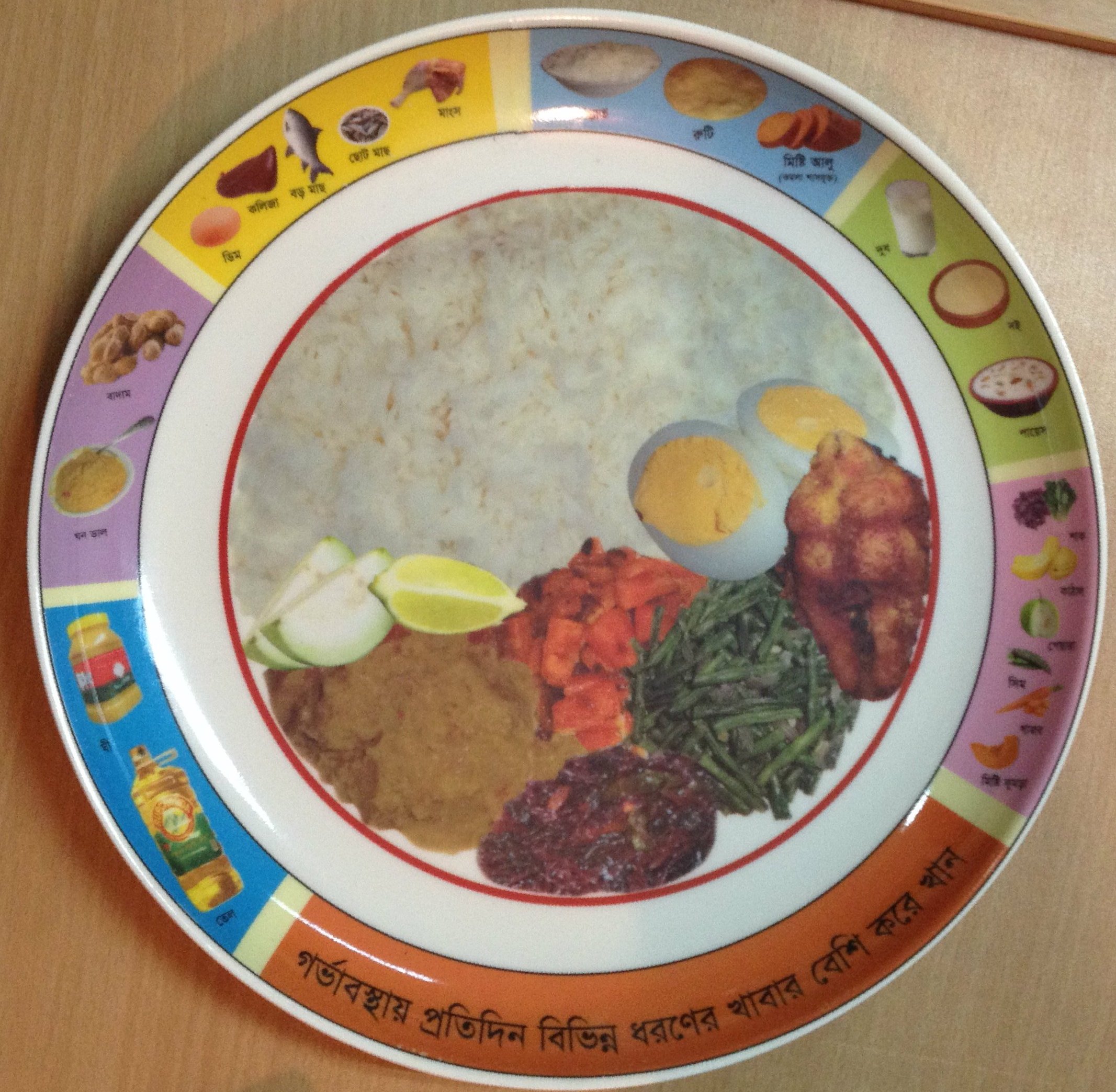 |
Photo quality was poor Cultural acceptability (for example, guava is generally not eaten with rice) Affordability of suggested foods (both egg and fish in same meal is not affordable for most women) No clear messages and about desired behaviours |
Table 2: Organisations/projects consulted during the development of the food plate
| 1 | Alive & Thrive |
| 2 | Bangladesh Institute of Research and Rehabilitation in Diabetes, Endocrine and Metabolic Diseases |
| 3 | Bangladesh University of Health Sciences |
| 4 | BRAC and BRAC University |
| 5 | Food and Agriculture Organization of the United Nations |
| 6 | Helen Keller International |
| 7 | Institute of Nutrition and Food Science, Dhaka University |
| 8 | International Potato Centre |
| 9 | Ministry of Food |
| 10 | SPRING |
| 11 | UNICEF |
| 12 | U.S. Agency for International Development |
| 13 | WASHplus |
| 14 | WorldFish |
| 15 | World Food Programme |
Table 3: Data collection methods and participants who provided data
| Method of data collection | Target audience | Number of participants | Total number of participants |
|---|---|---|---|
| 3A: Data collection during first round of field-testing | |||
| Focus group discussion | Preganant women | 11 | |
| Frontline nutrition workers | 5 | 16 | |
| In-depth interview | Nutrition workers and supervisors of BRAC | 5 | 5 |
| Key informant | Senior staff engaged in design and managing nutrition projects | 4 | 4 |
| 3B: Data collection during second round of field-testing | |||
| Focus group discussion | Rural women | 16 | |
| Frontline nutrition workers | 12 | 28 | |
| In-depth interview | Nutrition workers and supervisors of BRAC | 2 | 2 |
| TOTAL | 55 |
Table 4: Segregation of foods according to permissibility (accessibility) and aspiration (desirability) by pregnant women and frontline nutrition workers
| High permission | High permission | ||
| Low aspiration |
|
|
High aspiration |
| Low aspiration |
|
|
High aspiration |
| Low permission | Low permission |
Table 5: Comments of pregnant women and nutrition workers on quality of images and messages
| Features | Problems/suggestions |
|---|---|
| Complexity to understand pictures of different foods |
Confused mango with papya and hog palm with guava and olive Confused bean with okra / peas Chickpeas were poorly understood |
| Perception of illustration including background colour |
Flesh food and eggs should be in the same panel but in two different shades of background colour Glass of milk will look transparent |
| Font size | No problem |
Table 6: Two food plate options presented at the second expert consultation
| Photo of food plate | Main limitations |
|---|---|
| Option 1: | |
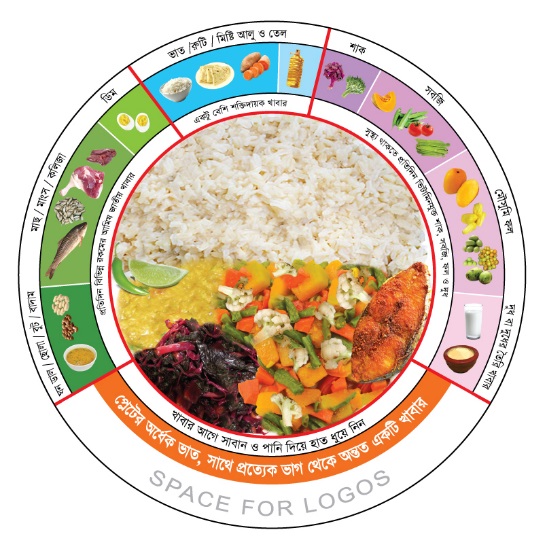 |
1: Protein (legumes and nuts, flesh and eggs in three shades of green) Message: Various protein-rich foods every day (alternative message: daily various protein for proper growth of foetus, but bigger baby is not desirable to avoid delivery complications) 2: Energy-giving foods (cereals, tubers and oil in two shades of sky blue) Message: A little more energy-giving foods 3: Foods to remain healthy coloured and green leafy vegetables, vegetables and fruits in four shades of purple Message: To remain healthy every day, vitamin-rich coloured and green leafy vegetables, vegetables, fruits and milk
|
| Option 2: | |
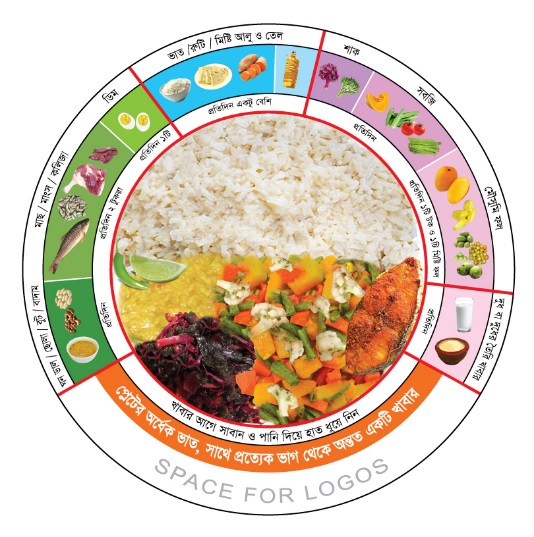 |
|
Table 7: Final version of the food plate
| Photo of food plate | Messages |
|---|---|
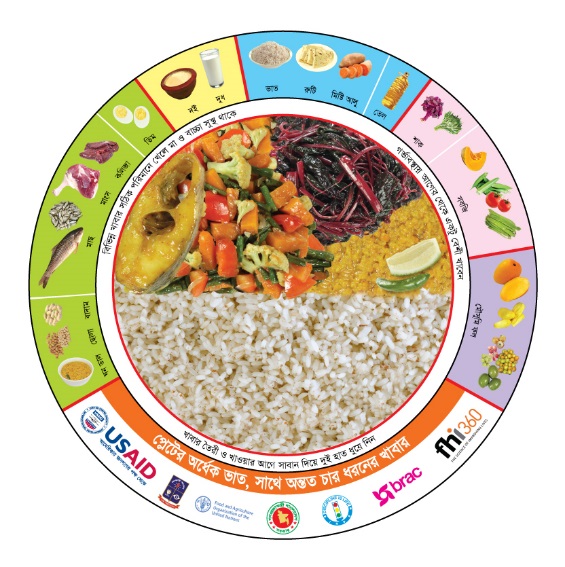 |
Prominent message: Half plate of rice and at least four other varieties of food Eating a variety of food in appropriate amounts keeps mothers and children healthy Eat a little more food during pregnancy Wash both hands with soap and running water before preparing and eating food |
References
Arimond M, Wiesmann D, Becquey E, Carriquiry A, Daniels MC, Deitchler M & Torheim LE, 2010. Simple food group diversity indicators predict micronutrient adequacy of women’s diets in 5 diverse, resource-poor settings. The Journal of nutrition, 140(11), 2059S-2069S.
BDHS 2011. Bangladesh Demographic and Health Survey 2011. National Institute of Population Research and Training, Mitra and Associates, and ICF International. 2013. dhsprogram.com/pubs/pdf/FR265/FR265.pdf
Fowles ER, 2004. Prenatal nutrition and birth outcomes. Journal of Obstetric, Gynecologic, & Neonatal Nursing, 33(6), 809-822.
Girard AW, & Olude O, 2012. Nutrition education and counselling provided during pregnancy: effects on maternal, neonatal and child health outcomes. Paediatric and Perinatal Epidemiology, 26(s1), 191-204.
Hermann J, Williams G, & Hunt D, 2001. Effect of Nutrition Education by Paraprofessionals on Dietary Intake, Maternal Weight Gain, and Infant Birth Weight in Pregnant Native American and Caucasian Adolescents. Journal of Extension, 39(1), n1.
Nahar Q, Faruque O, Sultana SS, Siddiquee AA, 2013. Dietary Guidelines for Bangladesh. Bangladesh Institute of Research and Rehabilitation in Diabetes, Endocrine and Metabolic Diseases. www.fao.org/3/a-as880e.pdf
Office of Disease Prevention and Health Promotion, 2015. Dietary guidelines. www.health.gov/dietaryguidelines. Accessed July 2015.
Osmani S, & Sen A, 2003. The hidden penalties of gender inequality: fetal origins of ill-health. Economics & Human Biology, 1(1), 105-121.
Piirainen T, Isolauri E, Lagström H, & Laitinen K, 2006. Impact of dietary counselling on nutrient intake during pregnancy: a prospective cohort study. British Journal of Nutrition, 96(06), 1095-1104.
Shamim AA, Christian P, Schulze KJ, Ali H, Kabir A, Rashid M, Labrique A, Salamatullah Q, & West KP, 2012. Iodine status in pregnancy and household salt iodine content in rural Bangladesh. Maternal & Child Nutrition, 8(2), 162-173. www.ncbi.nlm.nih.gov/pubmed/20977661.
Shamim AA, Kabir A, Merrill RD, Ali H, Rashid M, Schulze K, Labrique A, West KP & Christian P, 2013. Plasma zinc, vitamin B12 and α-tocopherol are positively and plasma γ-tocopherol is negatively associated with Hb concentration in early pregnancy in north-west Bangladesh. Public Health Nutrition, 16(08), 1354-1361. www.ncbi.nlm.nih.gov/pubmed/23469947.
Shamim AA, Mashreky SR, Ferdous T, Tegenfeldt K, Roy S, Rahman AKM, Rashid I, Haque R, et al, 2016. Pregnant women diet quality and its socio-demographic determinants in south-western Bangladesh. Food and Nutrition Bulletin 37 (1), 14-26.
Shamim AA, Schulze K, Merrill RD, Kabir A, Christian P, Shaikh S, Wu L, Ali H, Labrique AB, Mehra S, Klemm RD, Rashid M, Sungpuag P, Udomkesmalee E, West KP, 2015. First trimester plasma tocopherols are associated with risk of miscarriage in rural Bangladesh. The American Journal of Clinical Nutrition, ajcn-094920. www.ncbi.nlm.nih.gov/pubmed/25646326.
USDA 2011 [1]. United States Department of Agriculture. MyPlate. www.choosemyplate.gov. Accessed Feb 2015.
USDA 2011 [2] United States Department of Agriculture. MyPlate. www.choosemyplate.gov.Aug. 2011. Accessed Oct 4, 2013.

